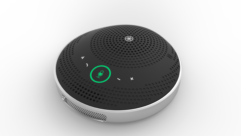
Unified Communications at InfoComm 2014
Aug 19, 2014 10:03 PM, By David Danto, IMCCA director of emerging technology

When InfoComm 2014 came to a close on June 20, it left attendees in something of a quandary. Many I spoke with were unimpressed by the technology shown in Las Vegas this year, with one commentator even calling it an “evolution, not a revolution.” While I can understand the sentiment—with few, if any “wows” being shown by exhibitors—what became clear to many of us was that the “wow” definitely was there, but in a slightly different way. After years of accepting the status quo in AV, the end-users were at this show, with an army, staging their own “we’re not going to take it anymore” protest that was most definitely nothing short of revolutionary.
Where’s Microsoft?
This was the 75th anniversary of InfoComm. And with record attendance (of nearly 40,000) and a stellar lineup of exhibitors, it was a fantastic conference and exhibition in many ways, both large and small. As long as I’m speaking about the large and the small, it was clear we had both covered with Microsoft this year. Microsoft was very big news earlier in the year—a first-time platinum sponsor of the show—representing at least a tacit acknowledgment from the IT- and software-centric world that AV actually existed. In contrast, no one could have predicted the utterly and abysmally embarrassing presence Microsoft turned out having at the expo. Tweets from those attending covered it in phrases such as “vast wasteland,” “desert,” “waste of money,” and “Where’s Waldo?”
Microsoft’s booth was a huge, carpeted space with a couple of displays, a sofa or two, some Surface PCs, oh, and space—let’s not leave out the vast areas of empty open space. Most in attendance were either surprised or offended by Microsoft’s uncaring attitude toward those that chose to carve out precious time to attend this conference looking to learn about products and solutions. In reality, it probably speaks volumes about how disjointed a firm Microsoft is that its communications people don’t even show up at the world’s preeminent communications conference. Perhaps there may have been some fear in Redmond, Wash., that Gurdeep Singh Pall’s “Era of Universal Communications” spiel wouldn’t cover it when there are actual communication experts in the room.
Attendees’ Presence
In reality, however, this year’s InfoComm wasn’t primarily about any of the exhibitors; it was about the attendees. The Unified Communications and Collaboration Solution Summit (co-presented by InfoComm and the unified communications association, IMCCA) showcased 10 sessions that were wall-to-wall packed with people representing end-user organizations.
For the most part, this group was tired of the “hang and bang” AV dealers shoving 30-year-old, expensive AV solutions at them. They came to this show to speak up about the need to view collaboration in the context of their entire communications ecosystem. The emergence of this theme—that the user experience is the key to communications and much more important than any technology— is as revolutionary as any past theme that emerged at previous InfoComm conferences. Even InfoComm Executive Director and CEO David Labuskes was quoted as saying that in order for the AV industry to remain relevant, it has to “accept the change … [including] seeing a greater dependence on collaboration and communications.”
Unified Communications at InfoComm 2014
Aug 19, 2014 10:03 PM, By David Danto, IMCCA director of emerging technology
Exhibitor Impact
As for the exhibitors and the technology shown, there are a few stories worth mentioning. As we’ve all been reading recently, the conferencing world has gotten quite a bit cloudier, with the latest news being LifeSize reinventing itself into a cloud services player and ClearOne merging a few individual acquisitions into an interesting cloud suite offering. Everyone is dubbing themselves the “Blue Jeans killer,” which kind of makes me wonder when we’re all going to stop and give Blue Jeans Network the kudos it deserves for waking up and steering the industry.
About one out of every three exhibitors was showing their own easy-to-use interactive display, which for the first time included Smart and its new Kapp. I’m still trying to figure out if I consider that product as a positive or negative step; perhaps the company has finally acknowledged all of its other stuff is way too complicated.
Also putting in a heavy presence on the exhibit floor was 4K/Ultra HD. While I give kudos to Vidyo for the first 4K soft room solution and Crestron for developing the first 4K end-to-end certified solution for AV, there are still thousands of AV users not even using HD and still thousands more who think Skype is good enough! A full 4K lifecycle is just showing off that you got an “A” on a test on which everyone else got a “C.” We already know you’re the smartest kid in the class; stop blowing the curve for the rest of us.
One important story to come out of Info- Comm is Dante. Audinate’s Dante is a digital media networking standard that delivers low-latency, high-quality sound over standard IP. It is newer and better than CobraNet and less pie-in-the-sky than AVB. A whole host of firms have signed on to using the technology. It seems to be a useful solution for the most complex audio challenges down to when you want to send a microphone signal from a conference room table over an existing network path.
Does the name Diamond Rio mean anything to you? While there may not be any Rio players left today, the company and the RIAA lawsuit against it forever changed how we consume and listen to music. That’s what comes to mind when I look at the Array Telepresence product shown at this year’s expo. Array is the first manufacturer to process small video cameras through a “black box” that manipulates the image into something different than the optics alone produce. The company is using the product to create the experience of an immersive telepresence room in a standard rectangular room with a standard rectangular table placed perpendicular to the screens. If you can’t picture that, go to the company’s website and look at the detailed explanation and photos. I predict that in five to 10 years, this external processing will be the norm in the video collaboration industry. Just as your music is now on an iPod and not a Rio, the norm may be floor-to- ceiling walls of video displays with fiberoptic cameras strung back to a processor, all put together in a way that simulates two sides of a clear piece of glass. Or it may be something else entirely. There is, however, no dispute that Array is the first.
Last, but not least, is Cisco, which showed its impressive lineup of new, modern collaboration endpoints and used the opportunity to back its “Everyone that wants to be interoperable with us will have to follow our standards” stance. In a blog post timed for the expo, Cisco wrote, “… to solve our customers’ challenges, Cisco has decided to expand our industry-leading interoperability to include two-way content sharing with Microsoft Lync 2013.” I’m sure that once the company gets this software change to the market, Cisco would like you to forget all about those silly Pexip and Acano guys, not to mention those nasty BlueJeans you shouldn’t wear. Unfortunately (or fortunately, depending on your perspective), it’s going to be impossible to put that genie back in the bottle.
David Danto has more than three decades of experience providing problem-solving leadership and innovation in media and unified communications technologies for various firms in the corporate, broadcasting, and academic worlds including AT&T, Bloomberg LP, FNN, Morgan Stanley, NYU, Lehman Brothers, and JP Morgan Chase. He now works with Dimension Data as the principal consultant for the collaboration, multimedia, video, and AV disciplines. He is also the IMCCA’s director of emerging technology. He can be reached at [email protected] or [email protected]. His full bio, other blogs, and articles can be seen at danto.info.









